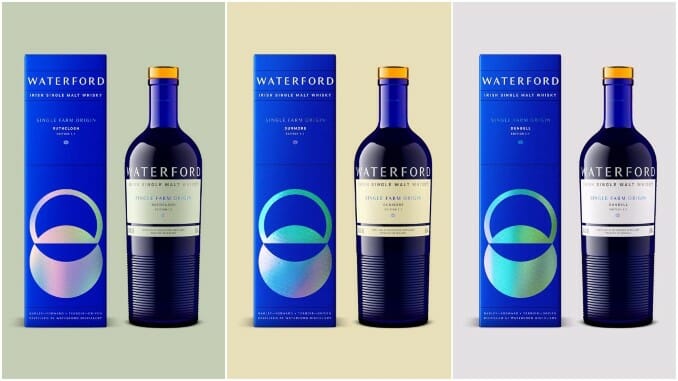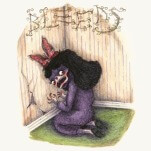Tasting: 3 Irish Single Malt Whiskies from Waterford Whisky
Photos via Waterford Whisky
The concept of terroir is an easy enough idea to understand, but a more difficult one to really demonstrate or quantify. It stands to reason, after all, that the same species of plant (such as grapes, or hops, or barley) would taste different when grown in different areas. It’s a basic extension of the butterfly effect—the same seeds, planted in two regions with different climates, and soil, and weather patterns, and farming techniques, will obviously yield very different results in many cases. And yet it’s not that easy for the consumer to find concrete ways of observing terroir for themselves.
Enter, a whisky-maker like Ireland’s Waterford Distillery. Located in the country’s oldest city of Waterford, on the southern edge of the island near the coast, this company focuses on exclusively on single malt Irish whiskeys (although they use “whisky,” like the Scots) that demonstrate terroir in the purest sense possible—each whisky is made with barley from one single farm. They call it “Single Farm Origin.”
It’s a very simple idea, but a radical one all the same. Making whisky with barley from single farms requires Waterford to manage their barley in a truly anal retentive way, keeping the lots from all farms separate from each other, while also dictating the size of batches. To date, though, the company has managed to work with almost 100 different farms, producing individually named and labeled bottles for all of them. Each heavy, blue glass bottles bears the name of its farm of origin, and has back text describing the farm and farmer. The website, meanwhile, has a full list of all the bottlings, and each bottle’s page contains information and photos of the farm and farmer. Truly, this is about as “whisky geek” as it gets.
In terms of the distillery’s own thoughts on terroir, they say the following:
Terroir is the 3D interaction on a plant of soil, microclimate and site. It influences how the barley grows and thus the flavours contained within the grain. Captured farm by farm, terroir requires an extensive logistical infrastructure to verify and prove its influence—each terroir is a new starting point for our whisky. We are fascinated by these nuances.
Each edition of Waterford Single Malt Irish Whisky is bottled at 50% ABV (100 proof). They’re non-age-stated, but carry the premium MSRP (about $100 in many U.S. locations) you’d expect for such a complex product with so much specialization and micromanagement. I was able to taste three different bottles (and thus three farms) of Waterford Whisky, so let’s get right to it. My farms were Dunmore, Rathclogh, and Dunbell.
Waterford Irish Single Malt — Dunmore Edition 1.1
According to Waterford’s extremely detailed background, which I won’t get into here, Dunmore is a farm owned by one John Tynan, so this is his malted barley that has been transformed into whisky via the subtle alchemy of malting, mashing, fermentation, distillation and aging.
I found Dunmore to be perhaps the richest and most decadent of the three Waterford malts I sampled, with a nose dripping in honey and biscuits. The nose is a tad on the doughy side, but also buttery, evoking honey butter and the fruitiness of apple butter, along with some more fennel-like spice.
On the palate, things move in a darker and more dried fruit direction, with notes of dark berries (blackberry, black cherry) and raisins, along with golden syrup and almond candy. This one almost gives off the vibe of a sherried single malt, although there’s no mention of any of these having actually gone into a sherry or wine barrel. Regardless, the Dunmore packs considerable sweetness and some really enticing fruit flavors, which would likely appeal to those who enjoy richer and more fruit-driven malts.
Waterford Irish Single Malt — Rathclogh Edition 1.1
You can read the whole spiel on the Rathclogh farm, owned by Richard Raftice, right here. Suffice to say, this single malt is also bottled at 50% ABV (100 proof) like the others, and I presume that other factors of aging, etc. were relatively the same. Unlike the Dunmore, however, I found the Rathclogh to contain much more classical “Irish single malt” flavors.
On the nose, this one has a pastoral sort of vibe—the nose is less assertive and more delicate, with impressions of fresh grain (Cheerios), green apple and hayloft/grass. It certainly doesn’t imply those dark, dried fruit notes I was getting from the Dunmore, or anything that would make a person wonder if sherry was involved. This feels like a lighter and drier dram on first inspection.
On the palate, this one is indeed somewhat less sweet, but it has more of a peppery and spicy quality—a bit hotter than the Dunmore, with the 100 proof showing a bit more of its strength here. There’s more grassiness, and some cooked apples, along with lighter honey and a blend of spice notes. Once you get past the initial alcohol, it proves to be probably the most balanced of these three drams, although I’m also not getting a huge “signature” presence from this one. It is, however, the closest to the template I traditionally think of when I think of Irish single malt whiskey.
Waterford Irish Single Malt — Dunbell Edition 1.1
The Dunbell single malt is close in name to the Dunmore, and they indeed share some other similarities as well—this one is closer in profile to the Dunmore than it is to the Rathclogh, that is for certain.
On the nose, we begin with some familiar honey and biscuit, but this one has more confectionery elements here as well, with vanilla evoking cookie dough or perhaps a freshly baked waffle cone. There are hints of dried fruit, although less assertive than in the Dunmore, and faint suggestion of coconut.
On the palate, I’m getting some stone fruitiness on this one, somewhere in the neighborhood of apricot or plum, along with toffee. It’s moderately sweet, with dried fruit and hints of coconut, and more than a little ginger. A nice nip all around, with well-incorporated alcohol and a well-balanced level of sweetness. It’s not quite as sweet as the Dunmore, but it covers some of the same territory, while also introducing more spice notes.
All in all, these were a fascinating trio to explore, and I’m sort of amazed that a company like Waterford would be able to resist the temptation to simplify their product lineup to static, unchanging brands. They are truly committed to exploring terroir in all its forms—something that may be a bit too heady for the whisky-drinking rank and file, but will always be welcome with the geeks.
Jim Vorel is a Paste staff writer and resident liquor geek. You can follow him on Twitter for more drink writing.










































